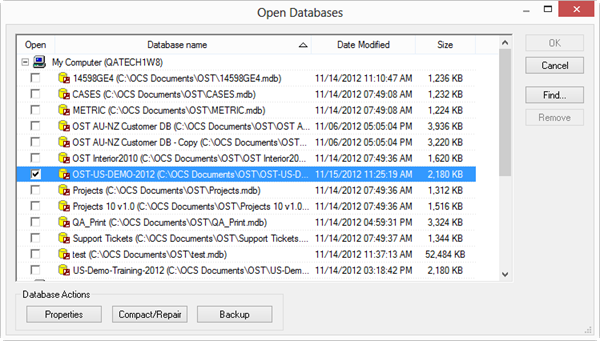You can open multiple databases at the same time. Although you can only work on one Bid at a time, keeping multiple databases open allows you to switch between projects and databases with just a few clicks. Many clients have databases for each job, estimator, regional area, etc. Each client determines how best to manage which databases are open (active) using the Open Databases dialog box.
Although there is no technical 'limit' to the number of databases On-Screen
Takeoff or Quick Bid allows a user to keep open at any one time, the more databases that are open the more system resources (system RAM) are required. This can affect application and system performance so keep only those databases in which work is actively being done open.
Opening Databases
To open one or more databases stored in the default database folder or that are already in your list,
Right-click anywhere in the Bids Tab and select Open, or
Click the Open icon,  on the Main toolbar, or
on the Main toolbar, or
Click File > Open
The Open Databases dialog box opens

Place a check in the check box next to the database name(s) you want to open
Click OK
If the database is password protected, type in the Login Name and Password in the dialog that appears, then click OK (click "remember me" to store this information - next time, you won't have to enter it when you open the program.)
There are a few buttons along the bottom of the screen:
- The Properties button opens the Database Properties dialog where you can make changes to the Backup, Auto-Compress, Measure Mode, login settings for a database.
- The Compact/Repair button runs a utility that compresses the database and reorganizes the tables to correct errors.
- The Backup button makes a copy of the selected database(s) and places them in the "Backup" folder specified in Tools > Options > Folders (the default location is "C:\OCS Documents\OST" (disabled when an SQL-type database is selected in the list - the program cannot backup an SQL database).
Along the right side of the screen:
- The Find... button opens a browse window for locating databases not stored in the default folder (see the next article for more assistance on Finding to open an Access database not stored in the default directory or an SQL database). We cover "finding" in the articles that follow.
- The Remove button removes Access databases that are not located in the default folder (if you haven't changed the "database" folder, that's "C:\OCS Documents\OST" and any SQL databases from the list of databases. The database reference is removed from the list, the database itself is unaltered.
Closing a Database
Closing a database does not change any data within the database, it simply removes the database from what is being displayed by the application. Open and close databases anytime - On Center recommends that you keep the fewest databases open to improve application performance.
To close a database, so it does not appear on the Bids Tab:
- Click File > Open to show the Open Databases dialog box
- Remove the check box next to the database name
- Click OK
You also can close a database by right-clicking on the database on the Bids Tab and selecting "Close".
